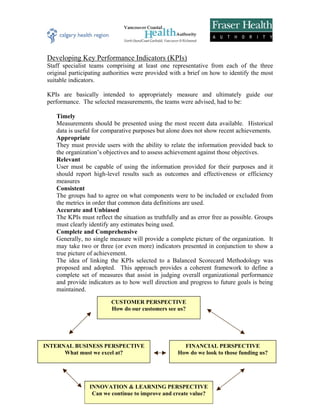Development%20of%20 Kp Is
- 1. Developing Key Performance Indicators (KPIs) Staff specialist teams comprising at least one representative from each of the three original participating authorities were provided with a brief on how to identify the most suitable indicators. KPIs are basically intended to appropriately measure and ultimately guide our performance. The selected measurements, the teams were advised, had to be: Timely Measurements should be presented using the most recent data available. Historical data is useful for comparative purposes but alone does not show recent achievements. Appropriate They must provide users with the ability to relate the information provided back to the organization’s objectives and to assess achievement against those objectives. Relevant User must be capable of using the information provided for their purposes and it should report high-level results such as outcomes and effectiveness or efficiency measures Consistent The groups had to agree on what components were to be included or excluded from the metrics in order that common data definitions are used. Accurate and Unbiased The KPIs must reflect the situation as truthfully and as error free as possible. Groups must clearly identify any estimates being used. Complete and Comprehensive Generally, no single measure will provide a complete picture of the organization. It may take two or three (or even more) indicators presented in conjunction to show a true picture of achievement. The idea of linking the KPIs selected to a Balanced Scorecard Methodology was proposed and adopted. This approach provides a coherent framework to define a complete set of measures that assist in judging overall organizational performance and provide indicators as to how well direction and progress to future goals is being maintained. CUSTOMER PERSPECTIVE How do our customers see us? INTERNAL BUSINESS PERSPECTIVE FINANCIAL PERSPECTIVE What must we excel at? How do we look to those funding us? INNOVATION & LEARNING PERSPECTIVE Can we continue to improve and create value?
- 2. Developing Benchmarks: Benchmarking sources approved by the specialist teams include: - Industry standards and acceptable ranges of performance - Targets for succeeding fiscal periods - Independently fixed measures by a hospital - MOH Guidelines - Standards identified and recognised by regional & international bodies Such benchmarking should allow a participating facility to self-assess against external standards and drive towards establishing higher expectations amongst its staff as well as serve as a guide for implementing change. The desired outcome of improvements in saved time and money would be to the attainment of a competitive advantage over peer institutions and recognition as a leading edge practitioner of best practice in the provision of healthcare services. In greater detail, the benchmarking shall allow for the following: 1) An objective, unbiased regional assessment that is accurate and superior to that of the quot;in-housequot; evaluations, which provides information on how they compare to each other and to “best-in-class” performers for specific processes; 2) By establishing a critical baseline or benchmark from which all subsequent evaluations will be made, progress and trends can be identified and tracked; 3) We hope to raises awareness levels for continuous quality improvement and create an atmosphere for improved performance and cost savings; the exercise provides access to the development of best practice tools and systems; 4) We aim to increase accountability and job quot;ownershipquot; by determining the level of staff adherence to established policies and procedures; 5) The establishment of benchmarks should substantiate and enhance employee incentive and provide a basis for bonus / penalty awards. 6) Identifies candidate areas for process reengineering, follow-up training and counselling; 7) Provides for the documentation of results, which in turn are an excellent source of strategic information for the non-medical portions of accreditation surveys, etc.

